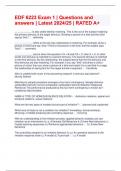EDF 6223 Study guides, Class notes & Summaries
Looking for the best study guides, study notes and summaries about EDF 6223? On this page you'll find 260 study documents about EDF 6223.
All 260 results
Sort by
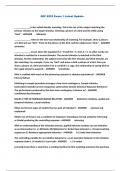 Popular
Popular
-
EDF 6223 Exam 1 Latest Update
- Exam (elaborations) • 5 pages • 2023
- Available in package deal
-
- $8.00
- 5x sold
- + learn more
EDF 6223 Exam 1 Latest Update ...
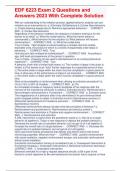 Popular
Popular
-
EDF 6223 Exam 2 Questions and Answers 2023 With Complete Solution
- Exam (elaborations) • 6 pages • 2023 Popular
-
- $7.99
- 2x sold
- + learn more
With an understanding of the imitation process, applied behavior analysts can use imitation as an intervention to: a.) Eliminate Old Behaviors b.) Evoke New behaviors c.) Create teaching sequences d.) Reinforce appropriate behaviors - CORRECT ANS b.) Evoke New behaviors Regardless of the behavior modeled, the objective of imitation training is for the learner to do what? a.) What the model does b.) What the trainer asked or commanded c.) What behavior fits the situation d.) What behavior w...

-
EDF 6223 Latest Update Graded A+
- Exam (elaborations) • 22 pages • 2024
-
- $9.99
- + learn more
EDF 6223 Latest Update Graded A+ •Combining Extinction with Other Procedures -The effectiveness of extinction may increase when it is combined with other procedures. -Differential reinforcement and antecedent procedures hold promise for reducing extinction effects such as bursting and aggression. •Establishing Operations -All stimuli that function as reinforcers require a minimum level of an establishing operation (i.e., motivation must be present).-"Resistance to extinction is gr...

-
EDF 6223 Exam 1 Questions and Answers Already Passed
- Exam (elaborations) • 9 pages • 2024
-
- $9.99
- + learn more
EDF 6223 Exam 1 Questions and Answers Already Passed _____________ occurs when the equation if A = B and if B = C, then A = C. In other words one stimulus is matched to a second stimulus. The second stimulus is matched to the third stimulus. By this relationship, the subject learns that the first stimulus and third stimulus are also matching. For example, if you say "bird" and show a child a picture of a bird, then you show a picture of a bird and match it to a real bird in a cage, the...

-
EDF 6223 Exam 2 Latest Update Graded A+
- Exam (elaborations) • 17 pages • 2024
-
- $9.99
- + learn more
EDF 6223 Exam 2 Latest Update Graded A+ 3 assumptions of level systems combined techniques are more effective than individual contingencies introduced alone, student behaviors and expectations must be stated explicitly, and differential reinforcement is necessary to reinforce closer and closer approximations to the next level 3 characteristics of behavior chains it involves the performance of a specific series of discrete responses; the performance of each behavior in the sequence p...
EDF 6223 EXAMS BUNDLE | Questions with 100% Correct Answers)
EDF 6223 Exam 1 | Questions and answers | Latest 2024/25 | RATED A+
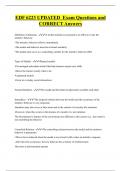
-
EDF 6223 UPDATED Exam Questions and CORRECT Answers
- Exam (elaborations) • 13 pages • 2024
-
- $8.49
- + learn more
Definition of Imitation - •A model stimulus is presented in an effort to evoke the imitative behavior •The imitative behavior follows immediately •The model and behavior must have formal similarity •The model must serve as a controlling variable for the imitative behavior (SD) Types of Models - •Planned models -Pre-arranged antecedent stimuli that help learners acquire new skills -Shows the learner exactly what to do •Unplanned models -Occur in everyday social interactions
EDF 6223 Exams Bundle || Questions with complete Solution| Verified Answers

-
EDF 6223 A Grade Exam | Questions with 100% Correct Verified Answers
- Exam (elaborations) • 6 pages • 2024
- Available in package deal
-
- $12.49
- + learn more
_____________is also called identity matching. This is the act of the subject matching the primary stimulus to the target stimulus. Showing a picture of a bird and the child saying "bird." - ANSWER reflexivity _____________ refers to the two-way relationship of matching. For example, show a picture of a bird and say "bird." Point to the picture of the bird, and the subject says "bird." - ANSWER symmetry _____________ occurs when the equation if A = B and if B = C, then A = C. In othe...
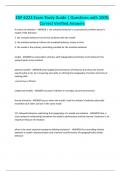
-
EDF 6223 Exam Study Guide | Questions with 100% Correct Verified Answers
- Exam (elaborations) • 14 pages • 2024
- Available in package deal
-
- $12.89
- + learn more
4 criteria of imitation - ANSWER 1. the imitative behavior is occasioned by another person's model of the behavior 2. the imitative behavior has formal similarity with the model 3. the imitative behavior follows the modeled behavior closely in time 4. the model is the primary controlling variable for the imitative behavior model - ANSWER an antecedent stimulus with topographical similarity to the behavior the analyst wants to be imitated planned models - ANSWER prearranged demonstrations...
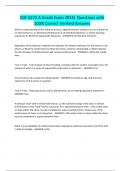
-
EDF 6223 A Grade Exam 2024| Questions with 100% Correct Verified Answers
- Exam (elaborations) • 9 pages • 2024
- Available in package deal
-
- $12.49
- + learn more
With an understanding of the imitation process, applied behavior analysts can use imitation as an intervention to: a.) Eliminate Old Behaviors b.) Evoke New behaviors c.) Create teaching sequences d.) Reinforce appropriate behaviors - ANSWER b.) Evoke New behaviors Regardless of the behavior modeled, the objective of imitation training is for the learner to do what? a.) What the model does b.) What the trainer asked or commanded c.) What behavior fits the situation d.) What behavior will re...

Study stress? For sellers on Stuvia, these are actually golden times. KA-CHING! Earn from your study resources too and start uploading now. Discover all about earning on Stuvia



